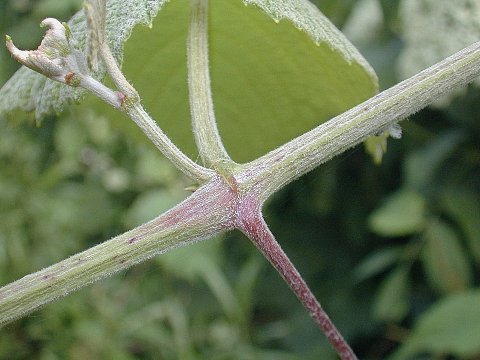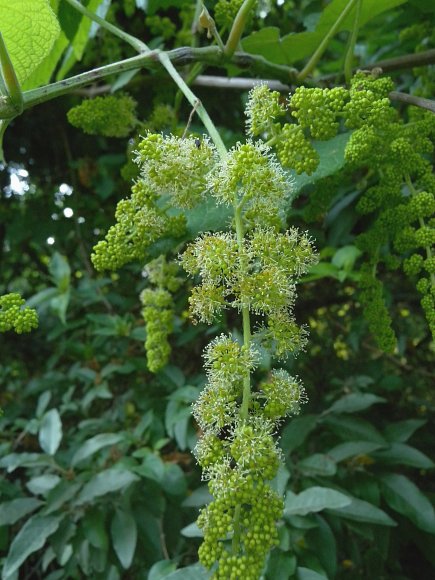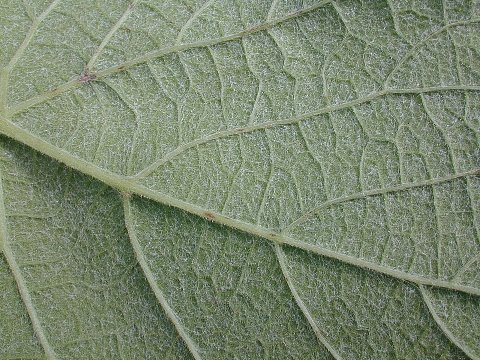Description: This woody perennial vine is up to 40' long, branching occasionally. It usually climbs over small trees, shrubs, or fence rows, otherwise it sprawls across the ground. A mature vine will develop a woody base with shaggy bark; younger branches are more slender and less shaggy. The non-woody branchlets are more or less covered with appressed hairs that are white or grey; these branchlets are often irregularly angular. The alternate leaves are up to 8" long and 6" across, although they are usually smaller. A typical mature leaf is cordate-orbicular in shape, dentate along its margins, and deeply indented at its base. The upper surface of this leaf is dull green, while its lower surface is densely covered with white cobwebby hairs that. A typical immature leaf is densely covered with white cobwebby hairs on both surfaces; its lower surface is often conspicuously white. The leaves are often divided into 3 lobes that are shallow and broad; they never have deep lobes. The petiole of each leaf is quite long and more or less covered with appressed hairs like the branchlets. Across from each leaf (except every third one), there is a single tendril and a multiple panicle of flowers or fruits.

The flowers are produced in drooping panicles up to 9" long and 4" across.The small flowers are yellowish green, consisting of 5 petals, 5 tiny sepals, and 5 stamens. These flowers can be perfect (bisexual), staminate (male), or pistillate (female); sometimes the staminate and pistillate flowers occur on separate plants. The blooming period occurs during the late spring and lasts about 2 weeks. There is a strong floral scent that is quite sweet. Each pistillate or perfect flower is replaced by an ovoid fruit containing 1-3 brown seeds. Initially this fruit is small and green, but it eventually becomes larger (about 3/8" or 1 cm. long), juicy, and black. The black surface of the fruit lacks a whitish bloom. The fruits of Winter Grape are sweet-tart when mature and edible. Each seed is 3-5 mm. in length. The root system consists of a taproot that is branching and woody. This plant spreads by reseeding itself.

Cultivation: The preference is partial sun, moist conditions, and a fertile loamy soil. Like other Vitis spp. (Wild Grapes), the foliage is vulnerable to various pests and disease. Under favorable conditions, the growth of this vine can be rampant; it can smother and kill small trees and shrubs.
Range & Habitat: The native Winter Grape occurs occasionally in southern and central Illinois; it is uncommon or absent in the northern portion of the state (see Distribution Map). Habitats include openings in moist woodlands, areas adjacent to woodland paths, partially shaded riverbanks, thickets, fence rows, and powerline clearances in wooded areas. This species usually doesn't wander far from thickets or wooded areas.

Faunal Associations: The flowers attract honeybees, bumblebees, and long-horned bees (Eucera spp.); see Robertson (1929). Other insects feed on the leaves, sap, wood, and other parts of Winter Grape and other wild grape vines (Vitis spp.). These insect feeders include the larvae of long-horned beetles, leaf beetles, weevils, scarab beetles (including the Japanese Beetle), larvae of gall flies, plant bugs, stink bugs, aphids, spittlebugs, leafhoppers, treehoppers, armored scales, Grape Phylloxera (Daktulasphaira vitifoliae), mealybugs, Giant Walkingstick (Megaphasma denticrus), thrips, and larvae of the following moths: Geometer moths, leaf blotch miner moths (Gracillariidae), shield-bearer moths (Heliozelidae), owlet moths (Noctuidae), Sphinx moths, and window-winged moths (Thyrididae). See the Insect Table for more information. The ripened fruit of wild grape vines is popular with many kinds of birds, including tanagers, crows, blackbirds, orioles, woodpeckers, thrushes, vireos, some warblers, some sparrows, and upland gamebirds (see Bird Table). These woody vines provide protective cover and nesting habitat for many birds, and narrow strips from their shaggy bark are sometimes used as construction material for their nests. Among mammals, White-tailed Deer and Domestic Goats browse on the foliage and smaller branches, while the American Black Bear, Gray Fox, American Red Fox, Virginia Opossum, Raccoon, Striped Skunk, Prairie Spotted Skunk, and Fox Squirrel eat the ripened fruit (Beeman & Pelton, 1980; Martin et al., 1951/1961; Blackmore, 1998; Sokala & Kirkpatrick, 1973). These birds and mammals distribute viable seeds of Winter Grape and other wild grapes far and wide. The Eastern Box Turtle also feeds on these fruits when they are within reach (Ernst et al., 1994).

Photographic Location: Photographs of the foliage were taken along a path in Busey Woods, Urbana, Illinois. The photograph of the flowers was taken at a woodland border in Pope County of southern Illinois.
Comments: Winter Grape is one of several native Vitis spp. (Wild Grapes) in Illinois. It can be distinguished from most species of Wild Grape by the cobwebby hairs on its branchlets, petioles, and leaf undersides. A notable exception is Vitis aestivalis (Summer Grape), which also has cobwebby hairs, although they are usually less dense and conspicuous. The leaves of Summer Grape occasionally have deep lobes, while the leaves of Winter Grape never have deep lobes. The branchlets of Summer Grape are round in circumference, while the branchlets of Winter Grape are usually angular. The seeds of Summer Grape are somewhat larger in size (5-8 mm. in length) and the surface of its fruit has a whitish bloom. Winter Grape has seeds that are only 3-5 mm. in length and its fruit lacks a whitish bloom.